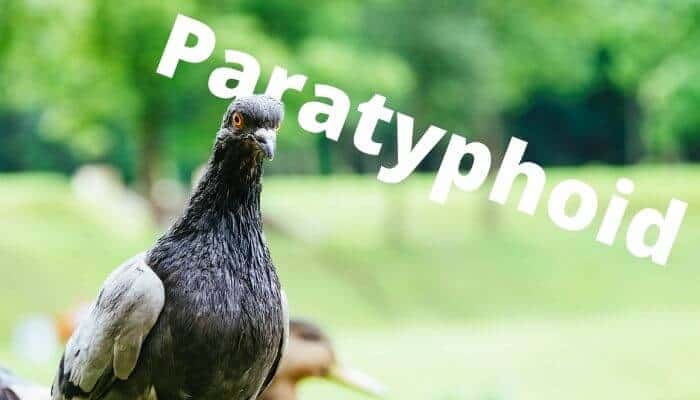Caused by the salmonella bacteria, paratyphoid is a danger to pigeons particularly in winter.
It is one of the most common bacterial diseases in racing pigeons.

Why is Paratyphoid a Concern?
Paratyphoid is one of the most common diseases infecting domestic pigeons, yet it is very often forgotten by owners.
This disease is often called winter’s silent killer.
It can move quite quickly through a flock of pigeons, making them sick and perhaps even killing some of them. It’s especially prevalent during the coldest months, which is the molting season and a time when pigeons spend quite a bit of time in close proximity to one another.
It can start small but can get out of hand quickly. It is also a vertically transmittable disease which means that parents can pass it on via eggs, producing a new clutch of chicks that are already infected.
As a bird owner, you need to know how to recognize and control it.
What is Paratyphoid?
Paratyphoid is a bacterial infection of the intestinal tract and bloodstream caused by one of three strains of the salmonella bacteria. This enteric infection is similar to typhoid and is spread via infected droppings which contaminate food, water and bedding.
There is one strain of the bacteria that is specific to pigeons – Salmonella var. Copenhagen.
The issue can be complex because like with all bacterial infections, some birds may carry the disease but not present any symptoms. Some birds can remain as asymptomatic carriers of paratyphoid even after treatment.
It only takes one infected pigeon for the problem to begin. The carrier pigeon will contaminate the loft with its infected droppings and gradually the water, food and bedding will become contaminated and spread to other birds.
Unfortunately, the bacterium is hardy and can remain in pigeon poop and dust for months.
The Disease
The infection begins in the intestine. The bloodstream then carries it to all other organs including liver, brain, spleen, and lungs, It also infects joints, muscles and skin.
Because it can also infect the ovary, any eggs that are laid will also be contaminated. In the case of an infected egg, the embryo may die, or the squab is born with the infection. If the squab survives, it may pass on the disease or, it may die within 4 – 14 days of hatching.
Adult pigeons with paratyphoid may die, recover or become asymptomatic carriers.
Symptoms of Paratyphoid
There is quite a list of symptoms:
- Swollen joints in the wings and legs
- Anorexia
- Weight loss
- Excessive thirst
- Drooping wings
- Ruffled feathers
- Refusal to fly
- Soiled feet and tail feathers
- Runny eyes
- Nasal discharge
- Diarrhoea
- Watery, green droppings
- Reproduction problems
- Embryonic or early squab fatality
- Death
Diagnosis of Paratyphoid
Diagnosis is made by identifying the presence of the salmonella bacteria in the bird. This is done either by an analysis of the bird’s droppings or from a culture from the joint fluid from a bird with a drooped wing.
Autopsies may be performed on dead birds or unhatched fertilized eggs.
Treatment of Paratyphoid in Pigeons
Swift action when one of your pigeons is sick is the best way to ensure that you keep the rest of the birds healthy and safe.
Antibiotics are the most effective treatment method, and a sensitivity test will tell what strain of the disease your pigeon has so that the appropriate medication can be used.
Be sure to separate any sick pigeons from the rest of the flock to help contain the spread of paratyphoid.
Your vet will prescribe the drugs and instructions should be followed. There are also proprietary medications designed to prolong the efficacy of the prescribed medication which are to be used after the course of treatment.
After any outbreak of paratyphoid, the pigeon loft needs a deep clean. Empty the loft of the birds and scrub with suitable cleaners or a disinfectant.
Prevention
It’s always better to take preventative measures rather than waiting until you have sick pigeons to deal with paratyphoid.
Quarantine any new pigeons you’re adding to your flock. This enables you to watch for signs of illness and keeps a pigeon away from the others until you’re sure it’s healthy. Some experts suggest continuing this quarantine until the new pigeon has successfully raised a brood of young.
Keeping the pigeon enclosure clean and sanitary is also important for preventing illnesses, including paratyphoid. Clean poop up regularly. Water bowls and bird feeders should also be cleaned and refreshed regularly.
Vaccination is another important step that helps encourage immunity to the disease.
Can Pigeon Paratyphoid Be Passed to Humans?
Paratyphoid is a zoonosis. This is an infection that can be transmitted from animals to humans. It is not common but occasionally may occur in the young and elderly, all fanciers should safeguard against catching the disease.
Safeguarding measures to take:
- Always wash your hands before and after handling your pigeons
- Use a hand sanitiser when in the loft
- Keep the loft clean and wear gloves when cleaning up bedding and any flooring materials.
- Avoid touching birds’ droppings
- Have clothes and shoes to wear when you are with your pigeons and keep these items away from the house, especially well away from the kitchen.
- Regularly monitor droppings to catch the disease early should it occur in your birds.
Unfortunately, paratyphoid is a fact of life for pigeon fanciers. Knowing how to recognize, treat and prevent the disease is important in the life cycle of your loft.

This article was written by our qualified veterinarian Cristina.
This is part of our commitment to providing you with the most trustworthy veterinary advice for your pigeons.
Sources:
